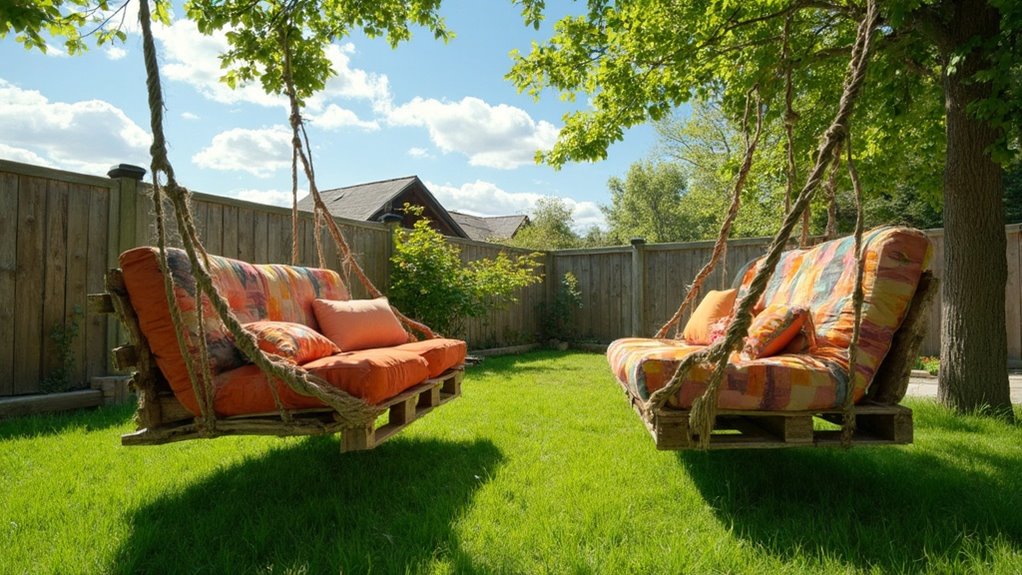We can create stunning DIY garden swings with recycled pallets and ropes, transforming simple materials into inviting outdoor spaces. Using 2-3 pallets, lumber, and sturdy rope, we can build a cozy swing bed that adds both style and sustainability to our gardens. We’ll customize our swings with paint and cushions to match our decor. Plus, there’s a step-by-step process to guide us along the way, ensuring we each can enjoy our personalized creations and the joy they bring.
Table of Contents
Key Takeaways
- Pallet swings are eco-friendly, using recycled materials to create versatile and customizable outdoor seating options for any garden space.
- Essential materials include 2-3 chemical-free pallets, 2×4 lumber for support, and high-quality rope for suspension.
- The construction process involves securing pallets with lumber, drilling holes for the rope, and ensuring stability before adding a mattress.
- Regular maintenance and safety checks are crucial, especially for households with children, to ensure the swing’s integrity and durability.
- Creative customization options, like vibrant paint, cushions, and decorative lights, enhance the aesthetic appeal of pallet swings in gardens.
Overview of Pallet Swings
When we think about adding a unique touch to our outdoor or indoor spaces, pallet swings come to mind as a versatile and creative option.
A pallet swing bed can transform any area into a cozy retreat. Constructing one involves using 2-3 pallets, 2×4 lumber, and pro-grade rope for safe suspension.
This design allows for endless customization, letting us adapt it to our personal style with paint or decorative elements. Not only do pallet swings evoke nostalgic memories of childhood, but they also promote sustainability by repurposing materials, making it a perfect environmentally friendly DIY project for all of us.
Popular Designs for Garden Swings
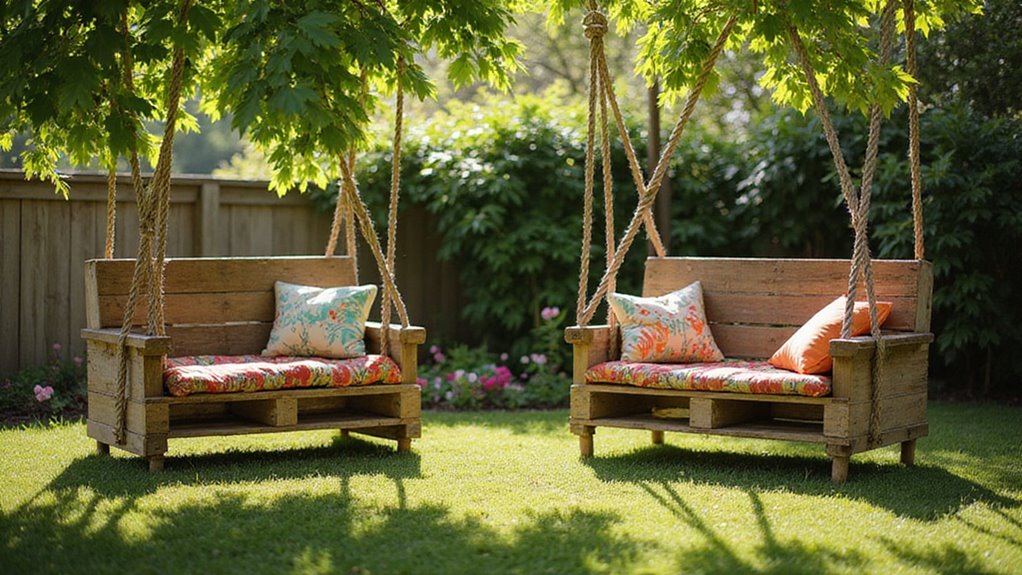
As we explore popular designs for garden swings, it becomes clear that there’s a style to suit every taste and space.
Floating pallet swings, with an extra pallet on top, offer room for decorative touches like cushions or lanterns.
For indoor settings, pallet swing chairs add a playful element, transforming creative spaces such as offices or playrooms.
If relaxation is what we seek, indoor pallet bed swings combine the comfort of a bed with soothing movement.
With versatile designs, pallet swings can be customized to fit any aesthetic, making them an ideal choice for both small backyards and expansive gardens.
Materials Needed for DIY Pallet Swings
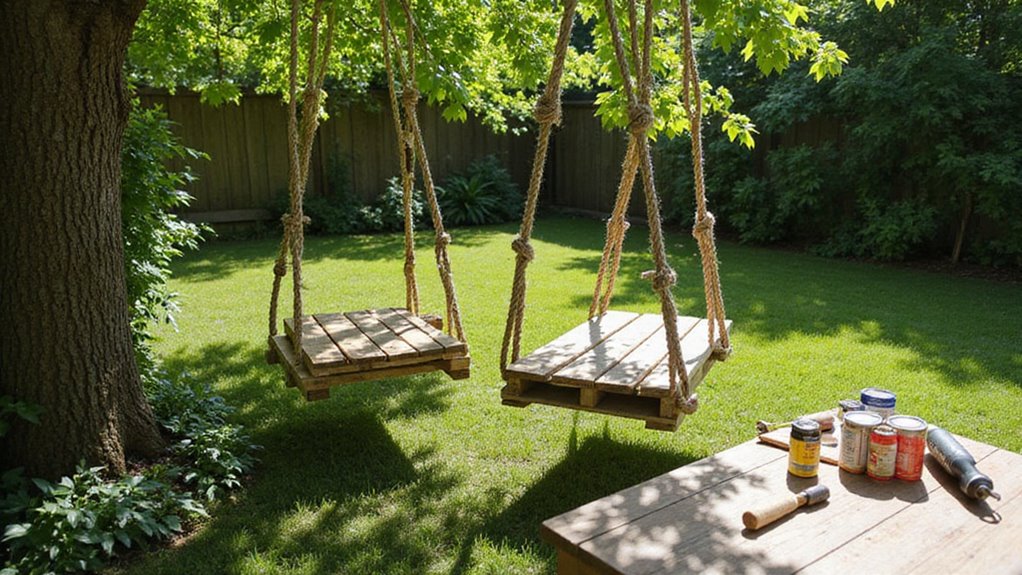
To create a DIY pallet swing, we need to gather essential materials that guarantee both safety and durability.
First, we’ll need 2-3 pallets, ensuring they’re free from chemicals. Next, three 8-foot pieces of 2 x 4 lumber will provide critical structural support. A drill and screws are fundamental for securely assembling the pallets and lumber.
For suspension, we should select high-quality, solid braid pro-grade rope with a working load limit of at least 700 pounds.
Additionally, optional materials like paint can enhance the swing’s appearance, while vinyl covers will protect the mattress, ensuring longevity and style.
Step-by-Step Construction Process
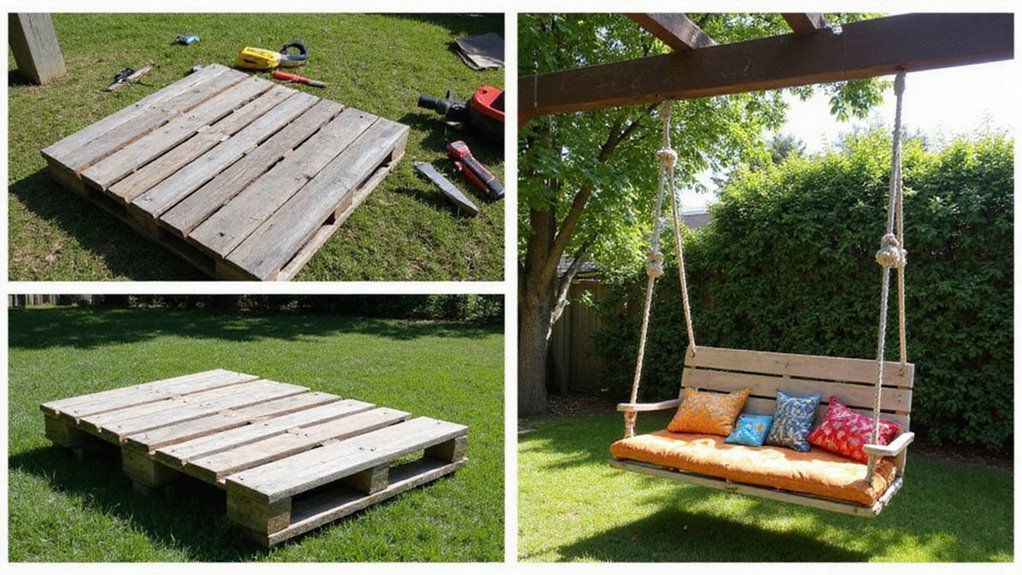
Before we plunge into the construction process, it’s essential to guarantee we’ve a clear plan in place.
First, we’ll measure our mattress to determine how many pallets we need—typically 2-3.
Next, we cut and insert three 2×4 lumber pieces inside the pallets for support, securing them with screws.
We then drill holes in the corners for weather-resistant rope, ensuring they’re evenly spaced.
After threading the rope through, we tie it to a sturdy support point, like a tree branch.
Finally, we place the protected mattress on top, checking that all connections are tight and stable before enjoying our new swing.
Final Touches and Enjoyment
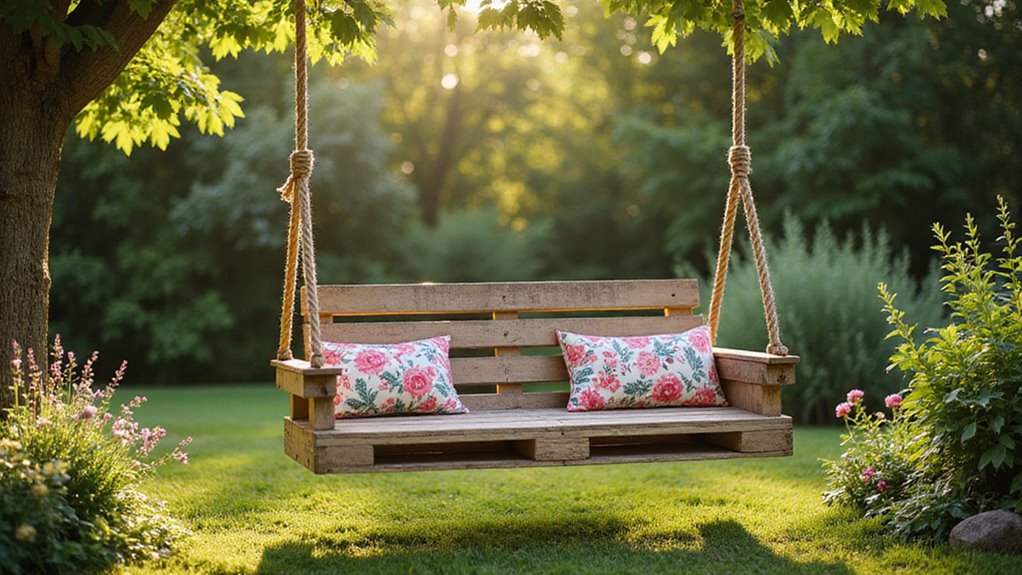
After we’ve completed the construction of our pallet swing, it’s time to focus on the final touches that will enhance both its functionality and aesthetic appeal.
First, let’s protect our zippered mattress with a vinyl cover to shield it from moisture and dirt.
Next, we should take a moment to admire our handiwork, appreciating how it elevates our garden.
To truly make it ours, we can customize with paint or personal décor.
Finally, we’ll regularly inspect the swing to guarantee safety.
This swing promises perfect spots for:
- Relaxation
- Reading
- Family bonding
- Enjoying summer days
Condition and Durability of Pallet Swings
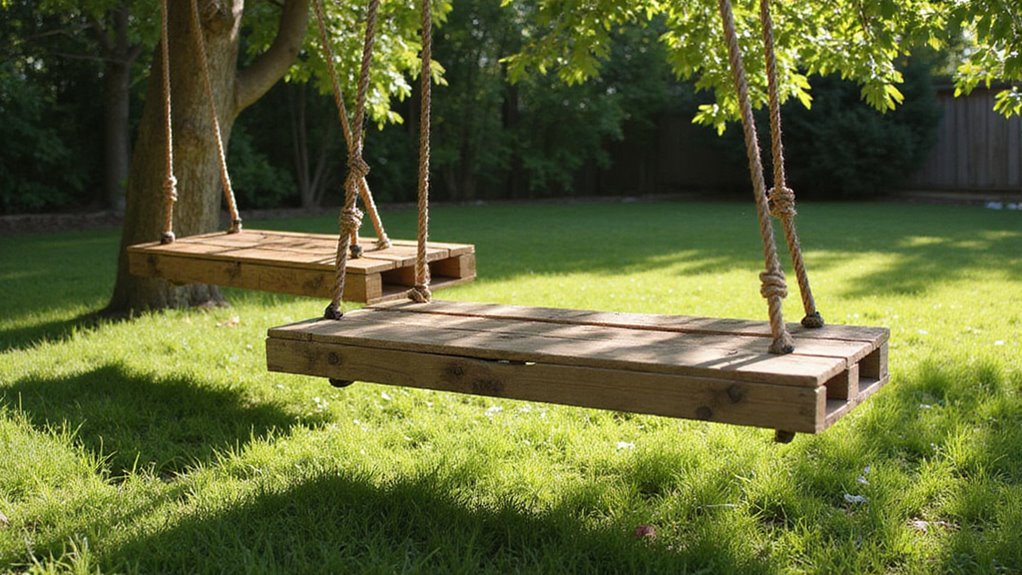
Having enjoyed our newly finished pallet swing, it’s important to contemplate its condition and durability to verify it remains a safe and inviting feature in our garden.
Pallet swings, crafted from weathered wood, offer rustic charm but require regular inspections, especially with kids around. We should monitor the ropes and verify they’re secured properly; high-quality ropes can withstand years of use but may need adjustments as they stretch.
To prolong the life of our swing, we can cover mattresses with protective vinyl, guarding against moisture and pests, and verifying our outdoor retreat stays delightful and functional for years to come.
Mattress and Cover Details for Swing Beds
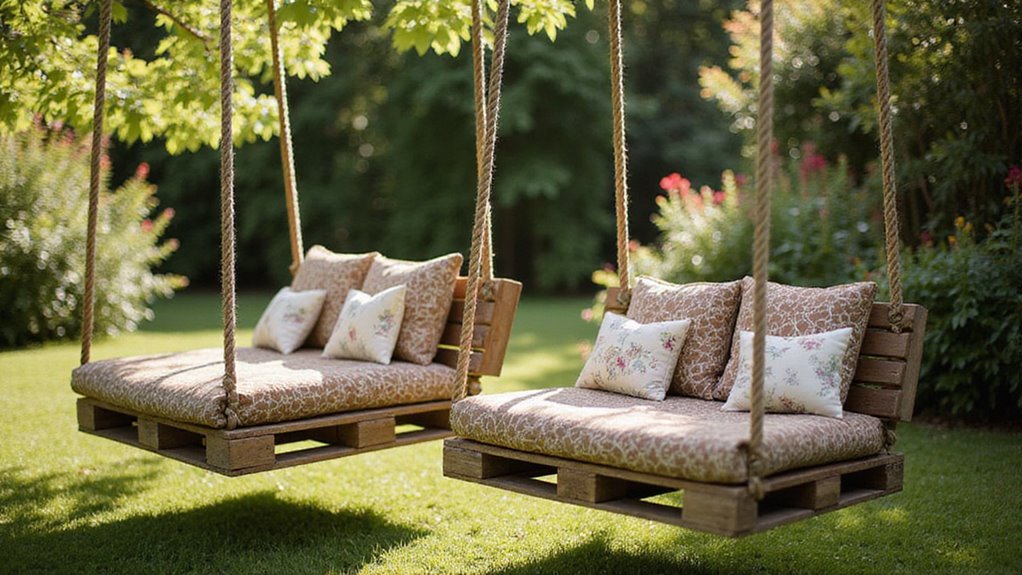
As we consider the comfort and longevity of our pallet swing beds, selecting the right mattress and protective cover becomes essential. A twin size mattress is ideal, offering ample lounging space.
To guarantee durability, we should use vinyl mattress covers to protect against moisture and insects. Here’s why choosing wisely matters:
- Prolongs mattress life
- Keeps our swings clean and fresh
- Enhances overall comfort
- Shields against the elements
Regularly replacing these mattress covers will maintain cleanliness and guarantee our swing beds remain inviting.
Opting for a plastic-covered mattress ensures better weather resistance, letting us enjoy our outdoor oasis longer.
Rope and Swing Functionality
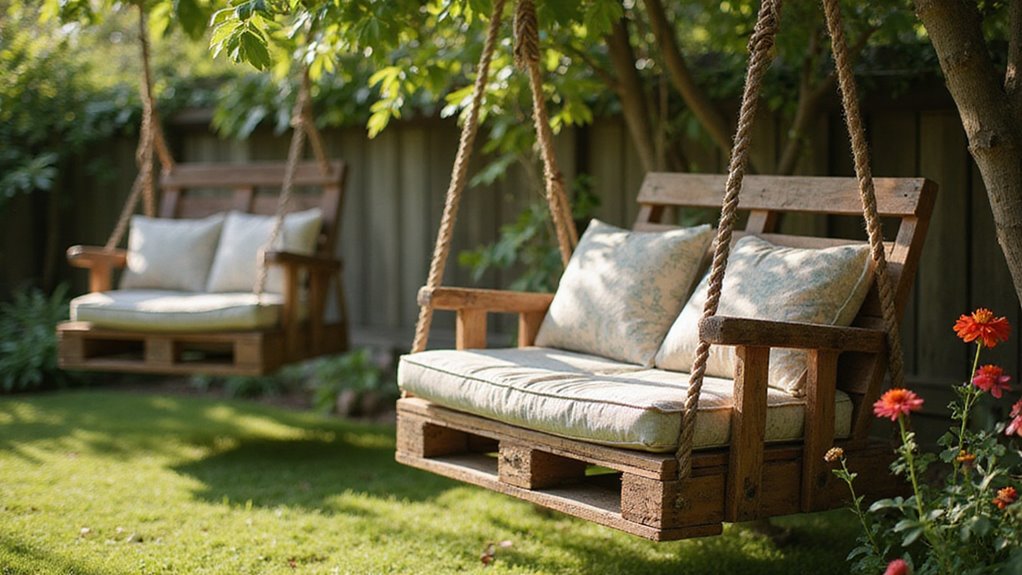
Ensuring our pallet swing beds are comfortable is just the beginning; the rope and swing functionality play a vital role in our overall experience.
We should select rope with a high working load limit, ideally 700 pounds or more, for safety and durability. As we install our swings, securely tying the rope around the support structure with multiple wraps and reliable knots enhances stability.
To boost enjoyment, we can incorporate additional rope for self-swinging functionality. Regular inspections for wear are essential, and replacing the rope as needed keeps our swings safe and functional for long-lasting enjoyment.
Community Engagement and Feedback
While we’ve enjoyed creating our DIY pallet swings, the community engagement surrounding this project has truly enriched the experience.
We’ve received wonderful feedback highlighting the swings’ nostalgic charm and practicality. Many of you have shared your successes in replicating the design, inspiring others to undertake their own DIY journeys.
- Suggestions for unique swing locations, like trees or porches
- Lighthearted debates on maintenance and aesthetics
- Creative ideas from fellow DIY enthusiasts
- Heartwarming stories of outdoor play
This vibrant exchange not only fosters creativity but also strengthens our community, making every swing a shared joy.
Project Considerations for Building Swings
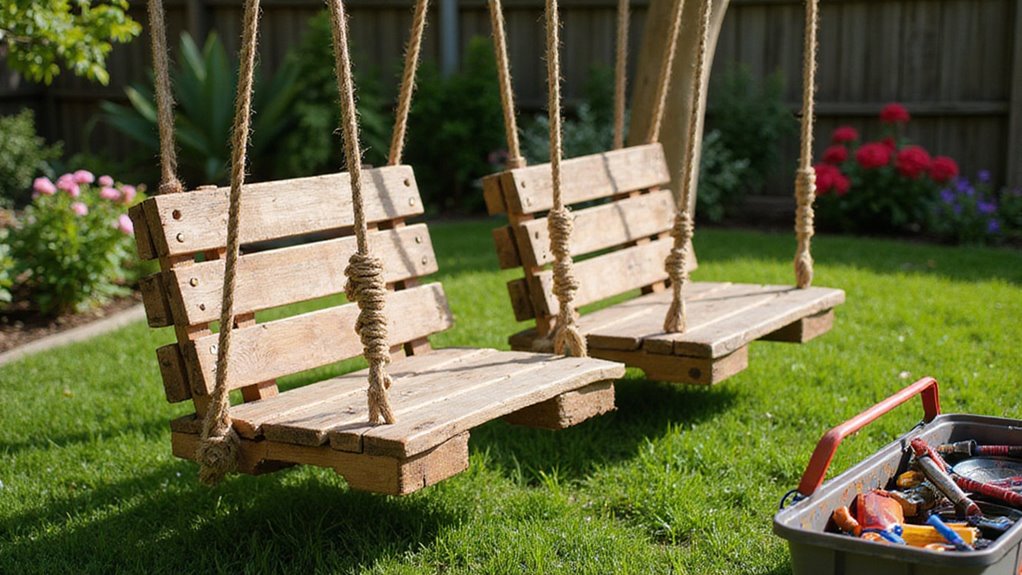
Building our DIY garden swings is an exciting project, but we need to take into account several important factors to guarantee safety and longevity.
First, let’s verify our pallets are untreated and free from chemicals.
Next, we should select a strong tree or support structure, ideally with a branch diameter of at least 8 inches.
Regularly inspecting the swing’s structure and ropes is vital for identifying wear.
We must also place the swing in a shaded area to protect it from sunlight.
Finally, let’s use UV-protected ropes with a high load limit to secure our swings safely outdoors.
Make certain we follow these project considerations for building swings!
Benefits of Creating a Garden Swing
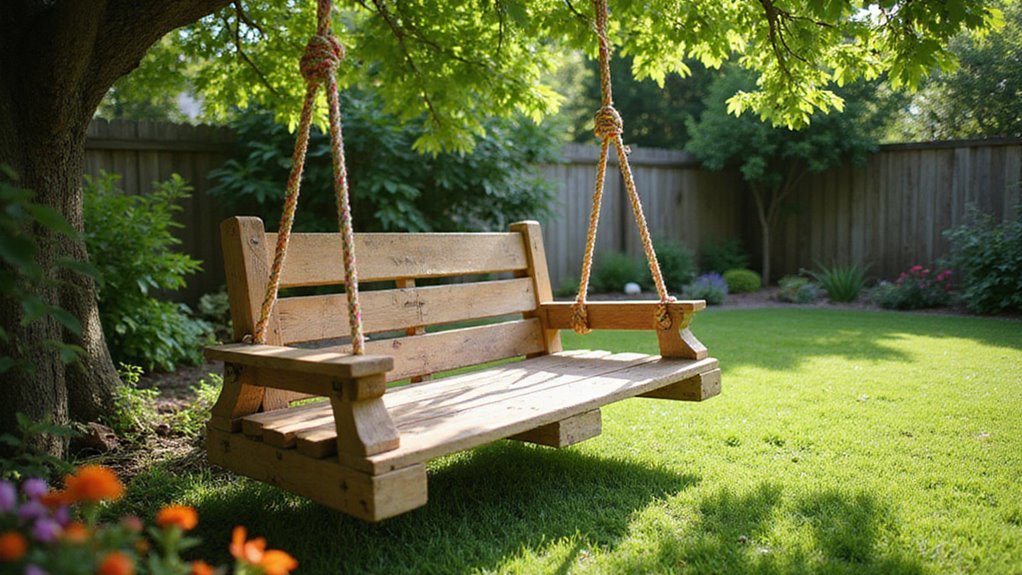
Creating a garden swing not only adds a charming element to our outdoor space but also offers numerous benefits for everyone who enjoys it.
The benefits of creating a garden swing are plentiful:
- Eco-friendly seating option from recycled pallets
- Encourages outdoor play and relaxation for all ages
- Fosters creativity and personalization in design
- Enhances our garden’s beauty, making it a gathering spot
Sourcing Pallets for Your Project
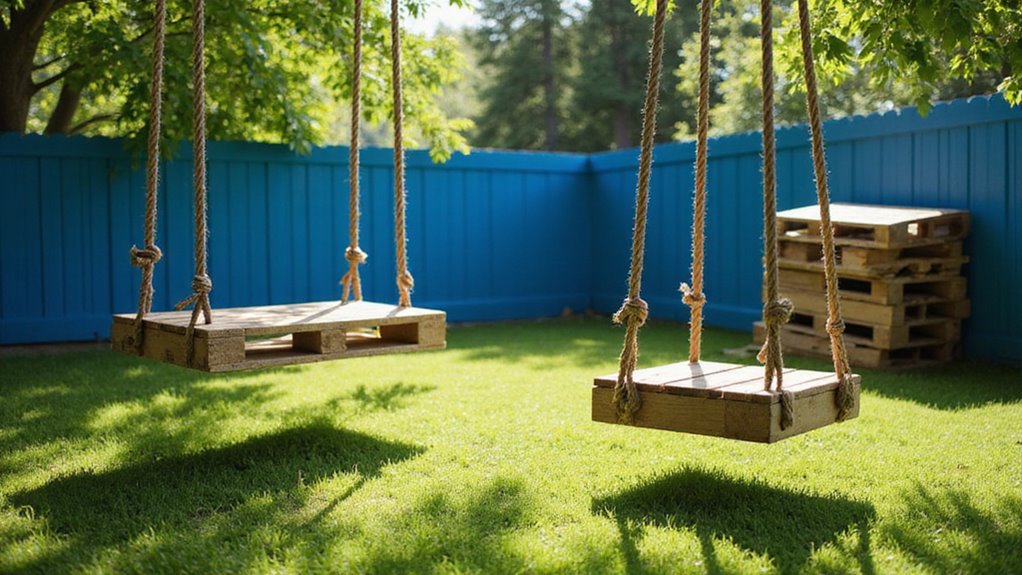
When we set out to build our garden swing, finding the right pallets is an essential first step. We can often source pallets for our project for free at local businesses, warehouses, or retail stores.
Look for the “HT” stamp on pallets to guarantee they’re heat-treated and safe for DIY use. Online marketplaces like Craigslist and Facebook Marketplace are great for finding free or low-cost pallets from individuals.
Additionally, check with local home improvement stores for their recycling programs. Always inspect pallets for damage or mold before using them to confirm our swing is sturdy and safe.
Safety Precautions During Construction
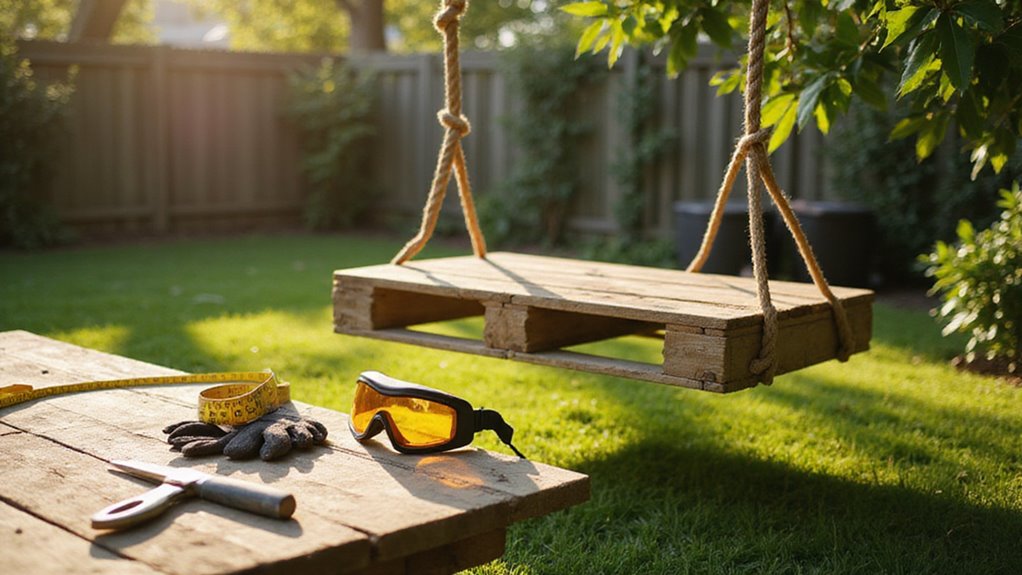
As we commence on our garden swing project, prioritizing safety during construction is essential to guaranteeing a successful build.
By adhering to important safety precautions, we can protect ourselves and our loved ones. Here are some significant steps to follow:
- Always wear safety goggles and gloves when using power tools.
- Check for the “HT” stamp on pallets to avoid hazardous chemicals.
- Maintain a clean, organized workspace to minimize accidents.
- Use a carpenter’s square to confirm secure connections.
Creative Painting Ideas for Pallet Swings
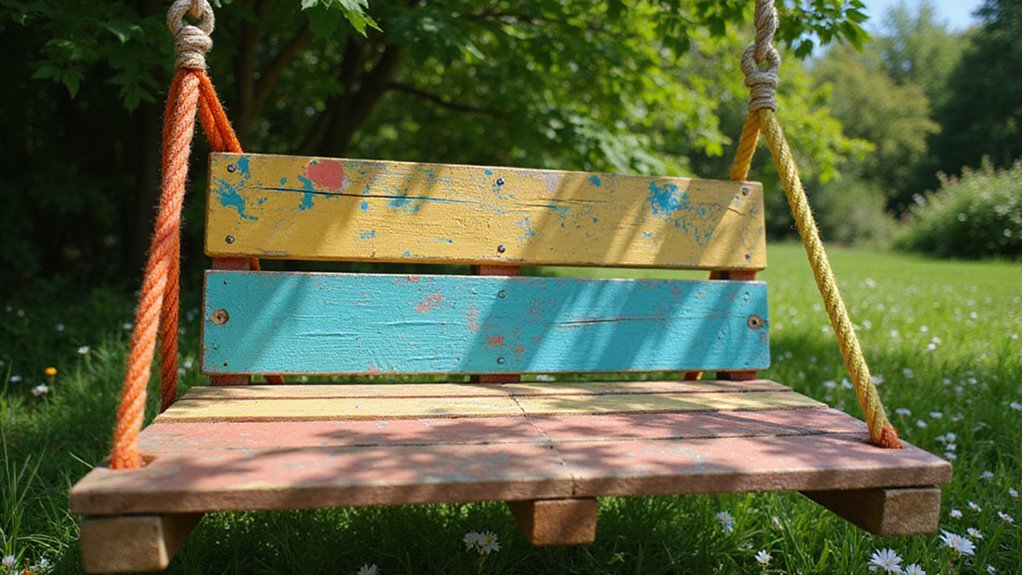
With safety measures in place during the construction of our pallet swing, we can now focus on bringing it to life with creative painting ideas.
Let’s use UV-resistant outdoor paint to protect our swing from fading and guarantee it withstands a high working load. We can stenciling designs or messages using painter’s tape for clean lines.
Vibrant colors or a gradient effect will make it pop in our garden. Nature-themed designs, like flowers or leaves, can help our swing blend into the environment.
Finally, applying a clear sealant will enhance durability against moisture and wear, completing our masterpiece.
Customizing Your Swing Design
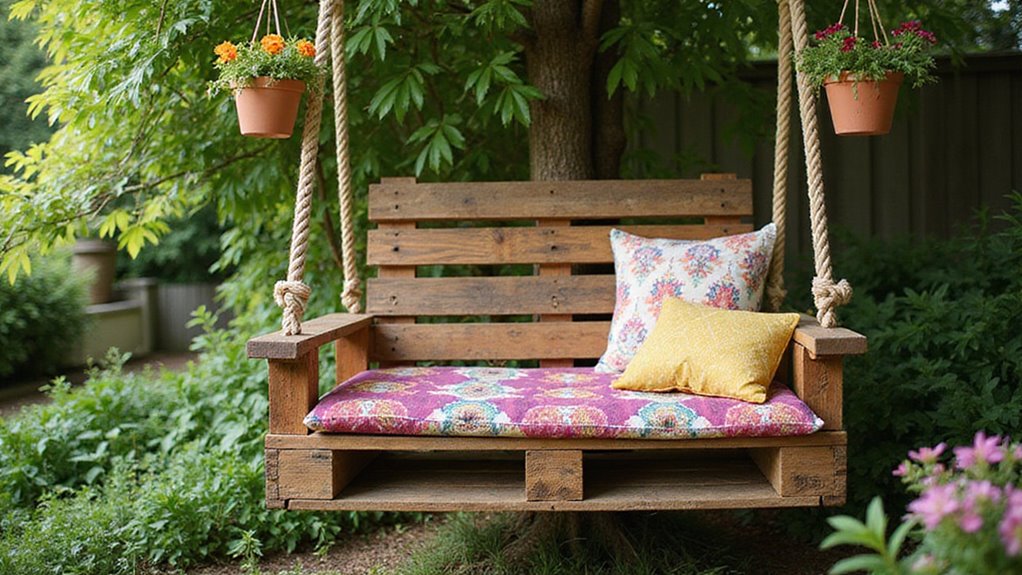
To truly make our pallet swing a standout feature in the garden, we can customize its design to reflect our personal style and enhance its functionality.
Here are some ideas for customizing your swing design:
- Paint with non-toxic outdoor paint to match our garden decor.
- Alter the swing shape with additional pallets for a unique look.
- Add vibrant cushions and throw pillows for comfort and flair.
- Hang fairy lights or lanterns for an inviting atmosphere.
Alternative Locations for Hanging Swings
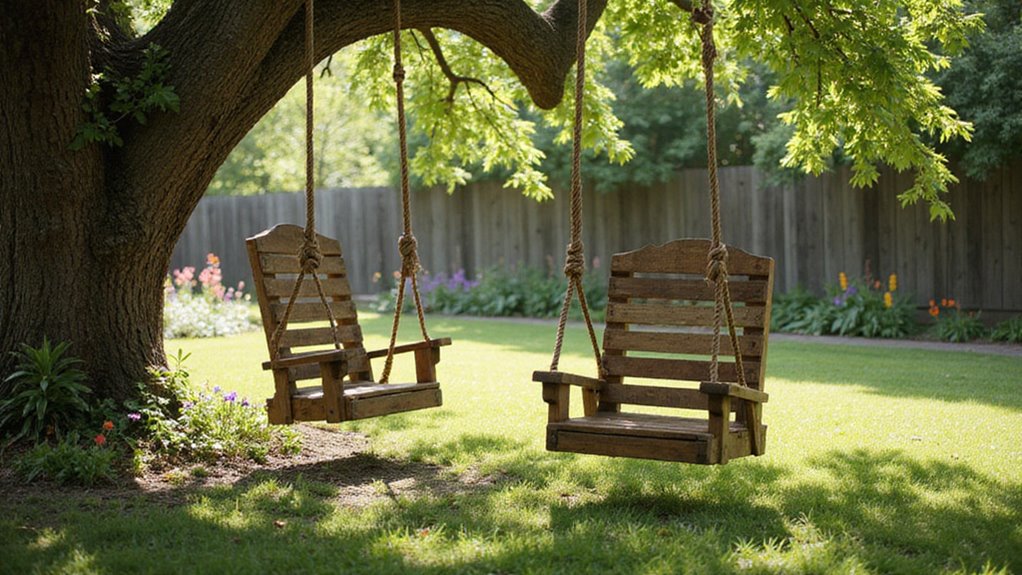
Finding the perfect spot for our garden swing can greatly enhance our outdoor experience, so we should consider several alternative locations for hanging swings.
Sturdy trees with thick branches, at least 8 inches in diameter, provide a natural setting. We can also use a pergola or gazebo to create a designated relaxation area.
Balconies and porches offer shaded, cozy spots, while a sturdy beam in our garage can transform indoor space into a playful retreat.
For a rustic touch, let’s hang swings from barn rafters, combining charm and functionality.
With proper credit given, these ideas can inspire our innovative swing setup!
Maintenance Tips for Pallet Swings
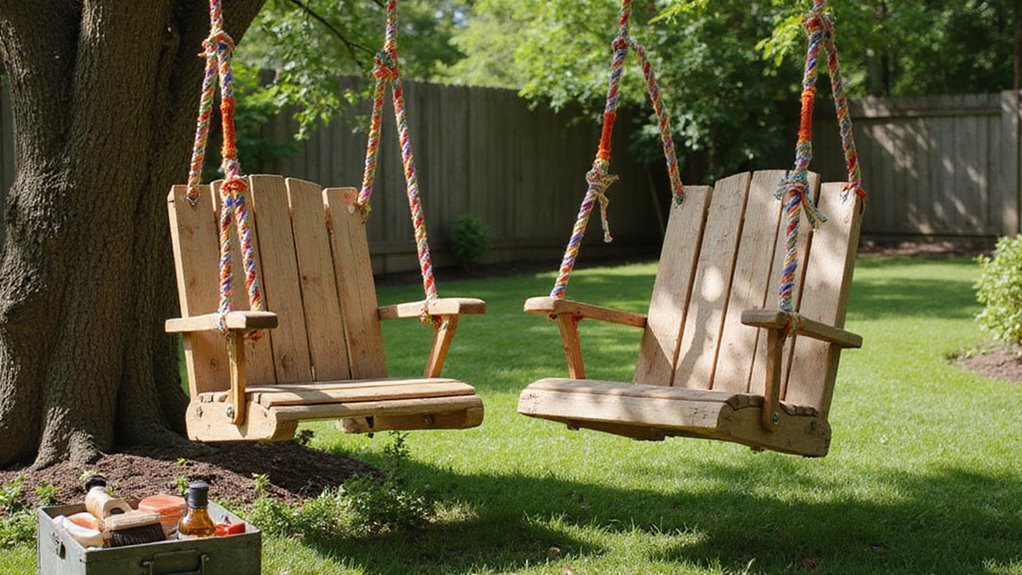
As we enjoy our pallet swings, it’s crucial to prioritize their maintenance to guarantee safety and longevity.
Here are some key tips to keep our swings in top shape:
- Regularly inspect the rope for fraying or stretching.
- Check the pallets and supports monthly, tightening screws and replacing damaged wood.
- Clean the swing with a damp cloth and apply weatherproof sealant.
- To keep your mattress dry, use a protective vinyl cover and store the swing indoors during harsh weather.
Ideas for Adding Cushions and Decor
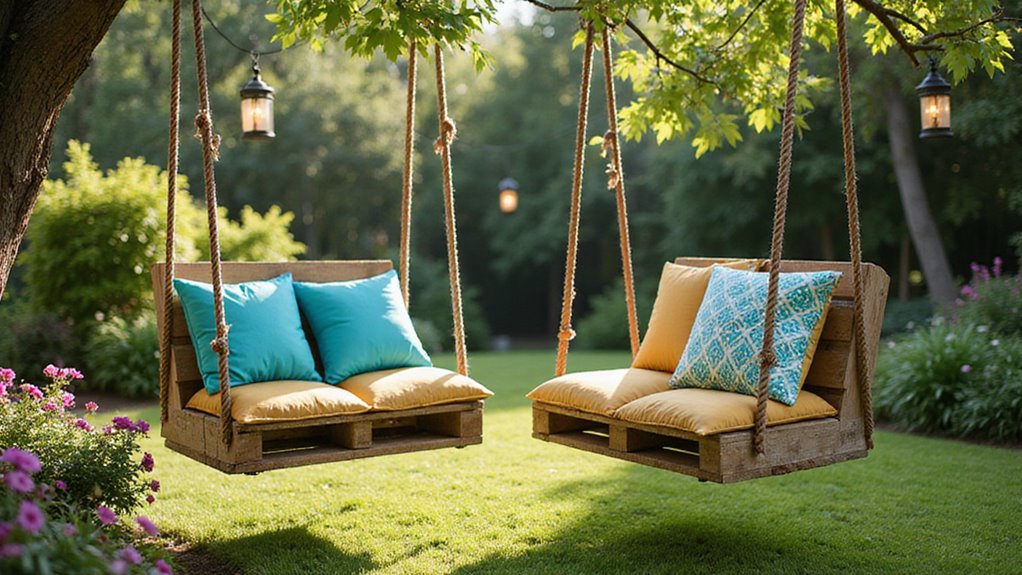
While we relax in our pallet swings, adding cushions and decor can greatly enhance both comfort and style.
Using weather-resistant fabric for our cushions guarantees they stand up to the elements, while offering a chance to customize colors and patterns.
Let’s add decorative throw pillows for a pop of color and extra support, making our swings inviting.
To create a cozy ambiance, we can hang string lights or lanterns nearby.
Protecting our cushions with a waterproof cover will keep them clean and free from pests, allowing us to enjoy our retreat throughout the seasons in style and comfort.
Using Pallet Wood for Other Outdoor Projects
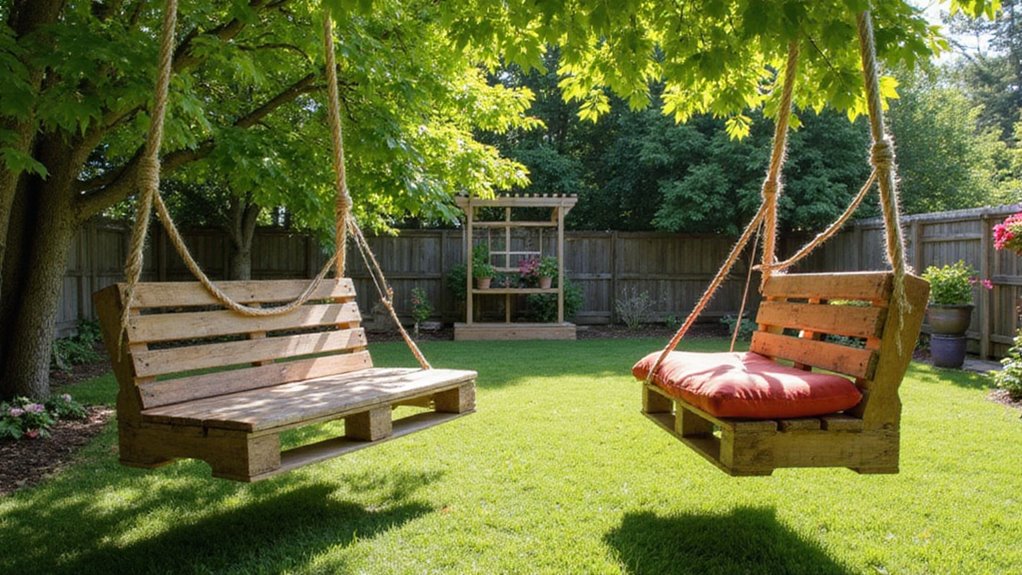
Since we often have leftover pallet wood from our garden swing projects, it’s a great idea to explore other outdoor creations that can enhance our backyard.
Here are some inspiring projects we can tackle together:
- Create sturdy garden benches for relaxation.
- Build raised garden beds for better soil drainage.
- Construct picnic tables for family gatherings.
- Design vertical gardens to maximize growing space.
Utilizing pallet wood not only reduces waste but also gives us the chance to customize unique pieces that reflect our personal style.
Let’s get creative and transform our outdoor spaces with these practical and innovative ideas!
Engaging Kids in the DIY Process
Getting kids involved in the DIY process can turn a simple garden swing project into an exciting family adventure. We can teach them basic math by measuring and selecting pallets, fostering spatial awareness and ownership.
Allowing them to paint or decorate the pallets sparks creativity and hones fine motor skills. By teaching knot-tying techniques, we enhance their problem-solving abilities.
Let’s create a fun challenge during assembly, instilling confidence through tasks like drilling holes or screwing in 2x4s. Finally, discussing safe swing usage promotes responsibility.
Engaging kids in the DIY process makes it memorable! [Photo here].
Inspirational Community Projects
After involving our kids in the exciting DIY process of creating garden swings, it’s inspiring to see how community members have taken this concept to new heights.
They’ve shared amazing projects using recycled pallets, showcasing creative designs that spark our imaginations.
Here’s what we love:
- The sustainability of using free or low-cost materials
- The nostalgic connection we all feel when swinging
- Collaborative tutorials that make DIY accessible
- Expanding ideas into pergolas or seating areas for enhanced outdoor living
These community projects not only bring joy but inspire us to engage in fun outdoor activities together, enriching our lives.
Showcasing Your Finished Swing
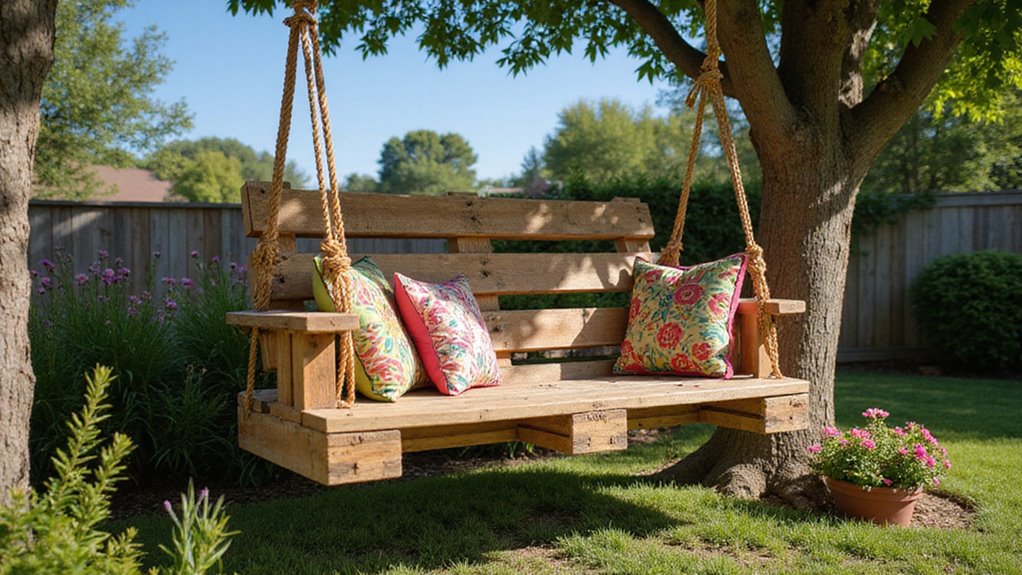
Once we’ve completed our DIY garden swing, it’s time to showcase our creation in a way that highlights its charm and functionality.
We should choose a safe location, like under a sturdy tree or spacious patio. To enhance aesthetics, let’s add outdoor cushions that match our garden’s colors.
For a cozy feel, we can decorate with hanging plants or fairy lights. Documenting our progress is important, so we should take photographs to share on social media, giving proper credit to our inspiration.
Finally, regular maintenance guarantees our swing remains safe and visually appealing for everyone to enjoy.

